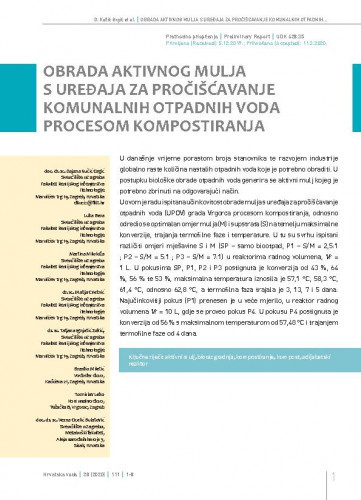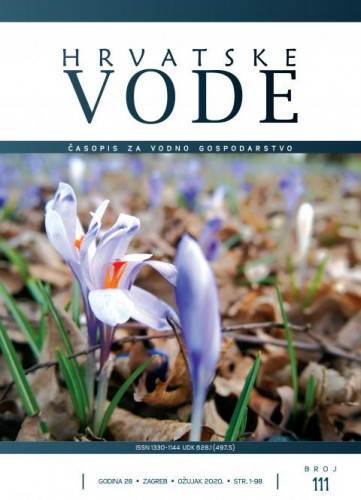U današnje vrijeme porastom broja stanovnika te razvojem industrije globalno raste količina nastalih otpadnih voda koje je potrebno obraditi. U postupku biološke obrade otpadnih voda generira se aktivni mulj kojeg je potrebno zbrinuti na odgovarajući način. U ovom radu ispitana je učinkovitost obrade mulja s uređaja za pročišćavanje otpadnih voda (UPOV) grada Vrgorca procesom kompostiranja, odnosno odredio se optimalan omjer mulja (M) i supstrata (S) na temelju maksimalne konverzije, trajanja termofilne faze i temperature. U tu svrhu ispitani su različiti omjeri mješavine S i M (SP – samo biootpad, P1 – S/M = 2,5:1 ; P2 – S/M = 5:1 ; P3 – S/M = 7:1) u reaktorima radnog volumena, Vr = 1 L. U pokusima SP, P1, P2 i P3 postignuta je konverzija od 43 %, 64 %, 56 % te 53 %, maksimalna temperatura iznosila je 57,1 °C, 58,3 °C, 61,4 °C odnosno 62,8 °C, a termofilna faza trajala je 3, 13, 7, i 5 dana. Najučinkovitiji pokus (P1) prenesen je u veće mjerilo, u reaktor radnog volumena Vr = 10 L, gdje se proveo pokus P4. U pokusu P4 postignuta je konverzija od 56 % s maksimalnom temperaturom od 57,48 °C i trajanjem termofilne faze od 4 dana.. At present, due to population growth and industrial development, there is a global increase in generated wastewater quantities that require treatment. Active sludge generated in the biological procedure of wastewater treatment requires adequate disposal. The paper examines the efficiency of sludge treatment at the Vrgorac wastewater treatment plant (WWTP) using the composting process. The optimal ratio of sludge (M) and substrate (S) was determined based on maximum conversion, thermophilic stage duration and temperature. To this end, different ratios of the S and M mixture were tested (SP – only biowaste, P1 – S/M = 2.5:1 ; P2 – S/M = 5:1 ; P3 – S/M = 7:1) in reactors of working volume Vr = 1 L. In the tests SP, P1, P2 and P3, the achieved conversion ranged from 43 %, 64 %, 56 % to 53 %, respectively, maximum temperature was 57.1 °C, 58.3 °C, 61.4 °C and 62.8 °C, while the thermophilic stage lasted 3, 13, 7 and 5 days. The most efficient test (P1) was transferred to a larger scale, in the reactor with working volume Vr = 10 L, where the test P4 was conducted. In the test P4, the achieved conversion equalled 56 %, with maximum temperature of 57.48 °C and thermophilic stage duration of 4 days.
Sažetak
Dio sveska

